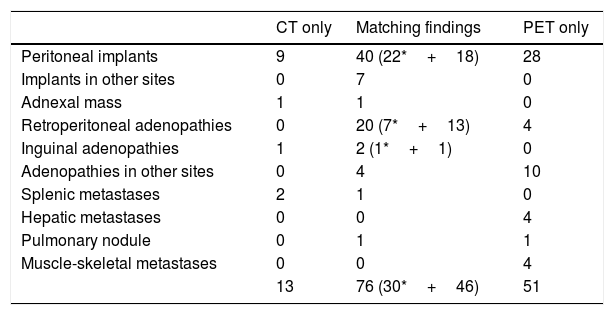To evaluate 18F-FDG-PET/CT for suspected ovarian cancer relapse with negative/inconclusive conventional imaging, or restaging potentially resectable ovarian cancer relapse.
Material and methodsThirty-six cases and 140 locations were studied. PET/CT, ceCT and serum CA-125 was conducted in all cases. Nineteen cases were requested for restaging, 17 for suspected relapse.
We compared ceCT and PET/CT, assessed by histopathology or radiological follow-up, calculating sensitivity (S) and positive predictive value (PPV) by cases and lesions.
We evaluated the correlation between size, number, uptake of the lesions and CA-125. We conducted survival analysis, using ROC curves to calculate the optimal cut-off of SUVmax for survival prediction.
We checked whether PET/CT modify the therapeutic attitude vs. conventional imaging.
ResultsPET/CT and ceCT were concordant in 12 cases: 11 positives (30 lesions), all confirmed. There was 1 FN.
In the 24 non-concordant, PET/CT was positive in 19 (97 lesions); ceCT in 21 (59 lesions); 54% of the lesions were concordant.
Overall, PET/CT detected 127 lesions, with S=97% and PPV=100%. ceCT detected 89 lesions, with S=61% and PPV=90%.
No significant correlation was found between CA-125 and the other parameters. PET/CT detected 10 positive cases, with normal CA-125.
PET/CT modified therapeutic management in 15 cases.
Significant differences were found in survival with SUVmax=11.8
ConclusionsPET/CT plays an important role in ovarian cancer relapse, with sensitivity and PPV higher than ceCT, modified therapeutic management in up to 42% of cases, and could be a valuable tool for predicting survival.
Evaluar el 18F-FDG-PET/CT en la sospecha de recidiva del cáncer de ovario con pruebas de imagen negativas/no concluyentes, y en la re-estadificación de recurrencia potencialmente resecable.
Material y MétodosEstudiamos 36 casos y 140 localizaciones. Se realizaron PET/CT, CT con contraste iv y CA-125 en todos los casos: re-estadificación (19), sospecha de recidiva (17).
Comparamos CT y PET/CT, valorados con histopatología y seguimiento radiológico, calculando sensibilidad y valour predictivo positivo (VPP) por casos y lesiones. Evaluamos la correlación entre tamaño, número y captación de las lesiones y el CA-125. Realizamos un análisis de supervivencia, utilizando curvas ROC para calcular el cut-off óptimo de SUVmax para predicción de supervivencia.
Comprobamos si el PET/CT modifica la actitud terapéutica vs imagen convencional.
ResultadosPET/CT y CT fueron concordantes en 12 casos: 11 positivos (39 lesiones), todos confirmados. Hubo 1 FN. En los 24 no concordantes, PET/CT fue positivo en 19 (97 lesiones); CT en 21 (59 lesiones); 54% de las lesiones fueron concordantes.
Globalmente, PET/CT detectó 127 lesiones (Sensibilidad=97% y VPP=100%) y CT 89 (Sensibilidad=61% y VPP=90%).
No se encontró correlación significativa entre CA-125 y los otros parámetros. El PET/CT detectó 10 casos positivos, con CA-125 normal. Modificó el manejo terapéutico en 15 casos. Se encontraron diferencias significativas en supervivencia (SUVmax=11.8).
ConclusionesEl PET/CT juega un importante papel en la recurrencia del cáncer de ovario, con sensibilidad y VPP mayores que el CT, modificó el manejo terapéutico en un 42% de casos y podría ser una herramienta útil para predicción de supervivencia.
Article
If you experience access problems, you can contact the SEMNIM Technical Secretariat by email at secretaria.tecnica@semnim.es or by phone at +34 619 594 780.

Revista Española de Medicina Nuclear e Imagen Molecular (English Edition)











